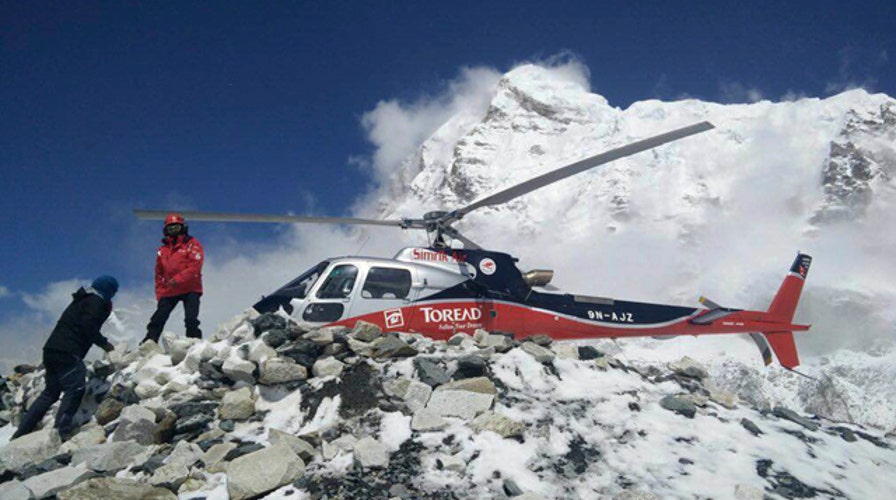As many as 200 climbers were still stranded on the side of Mount Everest and running low on food and heat early Monday following a devastating earthquake that triggered deadly avalanches, and officials were preparing to evacuating them by helicopter.
The climbers are mostly at Camp 2, some 21,000 feet above sea level, and cut off from base camp by boulders, blocks of ice and massive drifts sent down the world's tallest mountain by a series following Saturday's magnitude 7.8-earthquake and a series of aftershocks. Helicopter rescues were set to begin Monday, Zimba Zangbu Sherpa, immediate past president of the Nepal Mountaineering Association, told Bloomberg News in a Monday phone interview. At least 19 people, including a Google executive and a New Jersey medical worker, have already died.
Madison Mountaineering, a Seattle-based company that leads Everest expeditions, said on its website that the climbers in Camp 2 were safe and would attempt to reach Camp 1 for an air evacuation. They cannot get from Camp 1 to base camp because the passageway through the Khumbu Icefall is impassable, according to Madison officials. The group is running low on food and fuel for warmth, he said.
“At this point our only option to get down is by helicopter evacuation,” Madison wrote. “Our plan is to descend tomorrow to Camp 1 and hopefully with good weather fly to base camp to reconnect with the other members of our expedition who survived the avalanche.”
Dan Fredinburg, a Google executive who described himself as an adventurer, was among the dead, Google confirmed. Lawrence You, the company's director of privacy, posted online that Fredinburg was with three other Google employees hiking Mount Everest. The other three, he added, are safe. Fredinburg served as product manager and the head of privacy at Google X.
Twenty-two of the most seriously injured had already been taken by helicopter for treatment in the village of Pheriche, the location of the nearest medical facility. But bad weather and communications were hampering more helicopter flights, said Ang Tshering of the Nepal Mountaineering Association.
Later Sunday, a plane carrying 15 injured people arrived in the capital, Kathmandu, from Lukla, home of the closest airport to Mount Everest. Officials refused to provide details on their conditions, but most appeared to have broken bones or other treatable injuries.
Of those evacuated, 12 were Nepalese Sherpas. There was also one person each from China, South Korea and Japan.
The Sherpa survivors said they feared that many more people could be dead on Everest.
Pemba Sherpa, a 43-year-old guide with the right side of his face bandaged, was surprised he had survived.
He rushed from his tent when the earthquake hit Saturday and was standing in the open when "I heard a big noise, and the next thing I know I was swept away by the snow," he said. "I must have been swept almost 200 meters (yards)."
Later, he regained consciousness. "I was in a tent surrounded by some foreigners. I did not know what happened or where I was," he said after being taken to Kathmandu Medical College Hospital.
For generations, thousands of ethnic Sherpas, many of whom also use "Sherpa" as a surname, have made their livings working on mountaineering expeditions as guides, porters or cooks.
Saturday's magnitude-7.8 quake struck at around noon, just over a year after the deadliest avalanche on record hit Everest, killing 16 Sherpa guides on April 18, 2014.
Witnesses said the avalanche began on Mount Kumori, a 22,966-foot-high mountain just a few miles from Everest, gathering strength as it headed toward base camp and the lower reaches of Everest.
Numerous climbers may now be cut off on routes leading to the top of the world's highest peak.
Bhim Bahadur Khatri, 35, another survivor flown to Kathmandu, said he was cooking in a meal tent when the quake struck.
"We all rushed out to the open and the next moment a huge wall of snow just piled on me," he said in a brief airport interview before being driven to a nearby hospital. "I managed to dig out of what could easily have been my grave. I wiggled and used my hands as claws to dig as much as I could. I was suffocating, I could not breathe. But I knew I had to survive."
When he finally dug his way out, gulping in fresh air, he was surrounded by devastation. Part of the base camp village was gone.
"I looked around and saw the tents all torn and crushed. Many people were injured," he said. "I had lived but lost many of my friends."
More than 4,000 climbers have scaled the 29,035-foot summit since 1953, when Everest was first conquered by New Zealand climber Edmund Hillary and Sherpa Tenzing Norgay. The numbers have skyrocketed in recent years, with more than 800 climbers during the 2013 spring season.
The Associated Press contributed to this report.

